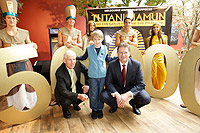Posted: 11 August, 2011
TUTANKHAMUN SHATTERS AUSTRALIAN RECORDS
'TUTMANIA' PROPELS EXHIBITION TO HALF-MILLION MILESTONE

Tuesday 9 August, 2011: Today Tutankhamun and the Golden Age of the Pharaohs became the most successful exhibition in Australian history announcing its 500,000th visitor.
Tutankhamun and the Golden Age of the Pharaohs had previously set a record when it opened to the public on 8 April with 150,000 tickets pre-sold. Now four months into its seven month run, the exhibition has exceeded attendance figures for all Australian exhibitions that have come before it.
Premier and Minister for the Arts Ted Baillieu said the exhibition was a coup for Victoria that has drawn local, national and international visitors of all ages to Melbourne.
"This fantastic exhibition is the talk of the town. It is the biggest cultural event of the year and arguably Australia's biggest major event for 2011."
"Beyond the buzz, the exhibition documents an important point in archaeological history. It follows the fascinating story of Egypt's boy king, the extraordinary cultural legacy of Egypt's "Golden Age" and the remarkable discovery of Tutankhamun's tomb by Howard Carter in 1922."
"The Melbourne Winter Masterpieces series has brought some fascinating and important exhibitions to Melbourne and it is exclusive events like this – and the staggering public response – that reinforces Melbourne's reputation as Australia's home of major events and the leading centre for the arts and cultural life in this country."
This figure ranks higher than Melbourne Museum's A Day in Pompeii in 2009 which attracted 332,679 people and Titanic the Artefact exhibition in 2010 which reached 480,879 in its six-month run. Interstate the highest attended exhibition had been the National Gallery of Australia's Masterpieces from Paris, which recorded attendances of 476,000.
Not only has Tutankhamun surpassed the previous record held by Titanic by almost 20,000 but it has done so in just four months.
Stephen Flint Wood, Managing Director of IMG Arts & Entertainment, said of the milestone "'Tutmania' is alive and well in Australia, and with another three months left in the run, this will be a precedent setting cultural event for the country. It is fantastic to see such excitement about a period in time which holds so much historical significance. We strongly recommend people book in advance for this once-in-a-life-time opportunity to see the treasures from Tutankhamun's tomb."
Other key figures for Tutankhamun and the Golden Age of the Pharaohs announced today:
- 35% of visitors to the exhibition are from interstate or overseas which makes it Victoria's leading cultural tourism driver.
- 90,000 school children from junior and secondary schools have enjoyed the treasures of the boy king. A Day in Pompeii recorded 30,000.
There are just three months left until the doors to Tutankhamun's treasures in Australia close on 4 December. This is the first visit of King Tutankhamun's treasures to Australia, and Melbourne is the exhibition's one and only stop on the continent. Advanced booking is recommended to guarantee desired date and time.
Tutankhamun and the Golden Age of the Pharaohs is a National Geographic exhibition that explores the figures who guided ancient Egypt more than 3,000 years ago. The exhibition focuses on the 18th Dynasty, a 250-year period when Egypt was at the height of its power and the "Golden Age" of Egyptian artistry. This was the era when Tutankhamun and his ancestors reigned.
The exhibition is organised by the National Geographic Society, Arts and Exhibitions International and IMG, with cooperation from the Egyptian Supreme Council of Antiquities. The Australian visit is made possible by a partnership with the Victorian Coalition Government, Victorian Major Events Company and Melbourne Museum.
[ DOWNLOAD PRESS RELEASE - pdf ]
[ RETURN TO NEWS ]





















